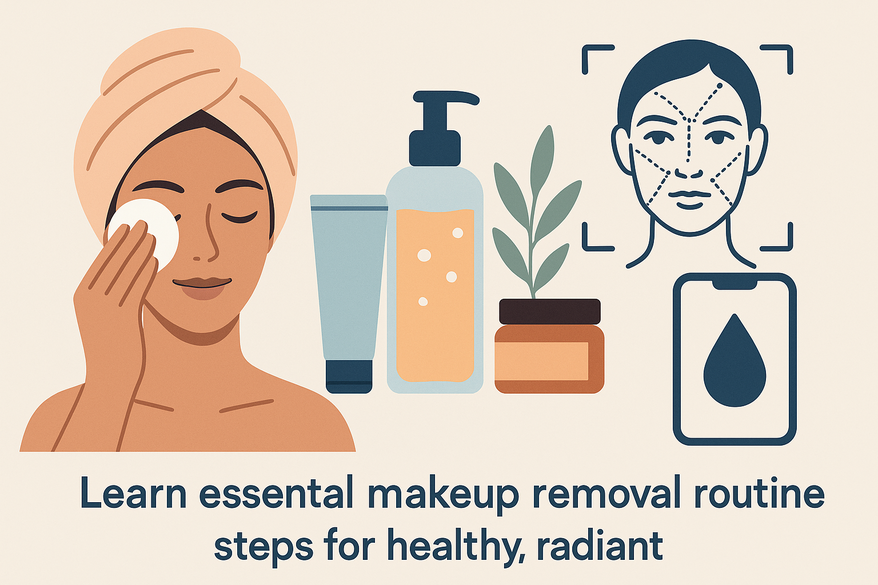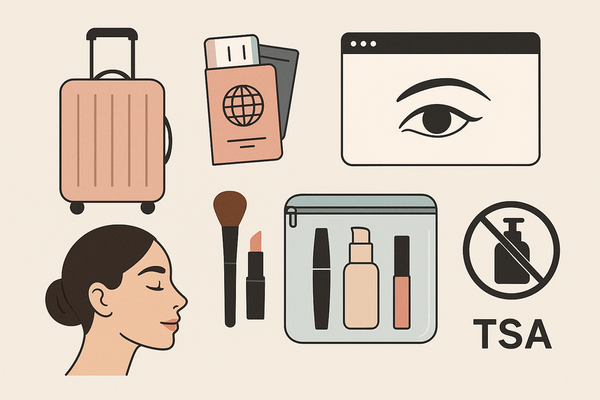Mastering Makeup Removal Routine Steps for Radiant Skin
Learn essential makeup removal routine steps for healthy, radiant skin. This guide covers the best practices and modern AI tools to enhance your skincare.

Estimated reading time: 8 minutes
Key Takeaways
- Nightly cleansing: Removing makeup and SPF every evening prevents clogged pores and supports skin renewal.
- Double cleanse: An oil-based first wash followed by a pH-balanced second cleanse ensures no residue remains.
- Target delicate areas: Gently remove eye and lip makeup first to avoid tugging and irritation.
- Embrace technology: An AI makeup generator can guide your product choices and cleansing intensity.
- Follow with care: Tone, treat, and moisturize to lock in hydration and optimize overnight repair.
Table of Contents
- Section 1: Understanding the Basics
- Section 2: Step-by-Step Guide
- Section 3: Integrating AI Makeup Generator
- Section 4: Additional Tips & Products
- Conclusion
- FAQ
Section 1: Understanding the Basics of Makeup Removal Routine Steps
Why Thorough Makeup Removal Matters
Consistent cleansing clears away cosmetics, sunscreen, and daily impurities, allowing your skin to breathe and restore its natural barrier. Without proper removal:
- Pores become clogged, leading to breakouts and irritation.
- Residual pigment accelerates visible aging and fine lines.
- Collagen renewal and overnight regeneration are impeded.
Dermatologists agree that a nightly makeup removal routine is essential to maintain healthy skin and boost the performance of your skincare products. For expert tips, see NIVEA Advice and GC Wellness Spa.
Common Mistakes and Pitfalls
Rushing or skipping key steps can do more harm than good:
- Harsh wipes: Relying solely on alcohol-based or abrasive wipes can strip the skin’s barrier and cause dryness. See Clinikally for safer methods.
- Neglecting eyes and lips: Aggressive rubbing around delicate areas can trigger redness, fine lines, and lash breakage. Learn more at Charlotte Tilbury.
- Skipping double cleansing: One cleanse often leaves behind oil, SPF, and debris.
- Poor tool prep: Failing to gather the right products or follow proper order reduces effectiveness.
Section 2: Step-by-Step Guide: Makeup Removal Routine Steps
Step 1: Prepare Your Tools
Gather these essentials before you begin:
- Soft cotton pads or reusable facial rounds
- Oil-based remover or micellar water for an initial breakdown
- Gentle, pH-balanced cleanser for the second cleanse
- Hair tie to keep hair away from your face
Pro Tip: Use room-temperature water to prevent sudden pore constriction.
Step 2: Remove Eye and Lip Makeup First
- Soak a pad with oil-based remover or micellar water.
- Press onto closed eyelids for 5–10 seconds to dissolve mascara and liner.
- Swipe gently downward, following lash direction to avoid tugging.
- For lips, press and sweep in one-directional strokes to lift stubborn tint.
Addressing these delicate areas first protects against irritation and fine lines.
Step 3: Initial Wipe for Face Makeup
- Use a fresh cotton pad soaked in remover to lift foundation, blush, and contour.
- Choose oil-based formulas for waterproof and long-wear products—they dissolve pigments more effectively.
- Work section by section: cheeks, forehead, nose, and chin.
Step 4: Double Cleansing
First Cleanse:
- Apply an oil-based cleanser to dry skin.
- Massage in gentle, circular motions to break down makeup, oil, and SPF.
Second Cleanse:
- Wet your face with lukewarm water.
- Apply a gel or cream cleanser that’s pH-balanced for your skin type.
- Massage lightly, focusing on the T-zone and jawline.
- Rinse thoroughly—avoid hot water to prevent dryness.
Step 5: Follow-Up Skincare
- Tone: Use an alcohol-free toner to rebalance pH and prep for treatment.
- Treat: Apply serums targeting hydration, brightening, or anti-aging.
- Moisturize: Seal everything in with a night cream or sleeping mask.
Section 3: Integrating Modern Technology: AI Makeup Generator
An AI makeup generator employs facial recognition, AR rendering, and machine-learning trained on thousands of styles to overlay digital looks on your live image.
Key Components:
- Facial recognition algorithms
- Augmented reality rendering engines
- Machine-learning models tuned to diverse makeup styles
Benefits for Your Routine:
- Virtual Testing: Try bold trends without physical products, reducing unnecessary skin exposure.
- Customized Cleansing: Adjust your routine intensity based on the digital look’s complexity (e.g., oil-first for graphic liners).
- Time-Saving: Eliminate product samples you won’t use, minimizing ingredient trial-and-error.
Case Study Example
User “Lily” uploads her selfie into an AI makeup generator. After previewing a dramatic cobalt eyeliner, she follows these steps the next morning:
- Oil-based remover pad on eyes for 10 seconds
- Double cleanse with a hydrating gel
- Alcohol-free toner and peptide serum
By aligning virtual trials with proper cleansing, Lily prevents pigment staining and irritation.
Section 4: Additional Tips for Makeup Removal Routine Steps and Products
Recommended Product Categories
- Oil-Based Cleansers: Balms or oils to melt away waterproof formulas
- Micellar Water: Gentle option for light makeup days or sensitive skin
- pH-Balanced Gel/Cream Cleansers: Tailored to oily, combination, or dry skin
- Alcohol-Free Toners: Restore barrier health and reduce redness
- Serums & Moisturizers: Look for ceramides, hyaluronic acid, and peptides
How to Choose the Right Products
- Check labels: “Non-comedogenic” for acne-prone, “fragrance-free” for sensitive skin
- Patch-test new items behind your ear for 24 hours
- Focus ingredients: ceramides or glycerin for dry skin; salicylic acid or niacinamide for oily/combo skin
For deeper insights, see our Best Makeup Remover Tips: Ultimate Guide and AI Insights or learn how to whip up your own cleanser with DIY Natural Makeup Remover + AI Makeup Generator Tips.
Conclusion
By mastering a consistent makeup removal routine—from tool prep through double cleansing and targeted hydration—you build the foundation for a clear, glowing complexion. Pair these time-tested steps with innovations like the AI makeup generator to explore new looks without compromising skin health. Share your nightly rituals and virtual makeup experiences below to inspire our community!
FAQ
Q: Are AI makeup tools safe for my skin?
A: Yes—they’re purely virtual, so there’s no direct skin contact. Always complete your makeup removal routine afterward to ensure no residue remains.
Q: My skin feels tight after cleansing; what now?
A: Switch to a hydrating, cream-based cleanser and consider reducing double cleansing frequency if you have dry or sensitive skin.
Q: Is it okay to use makeup wipes alone?
A: Only as a first step. Always follow up with a gentle cleanser to fully remove impurities and prevent buildup.
Q: How can I prevent eye irritation?
A: Use pads infused with soothing extracts (e.g., chamomile), press before wiping, and avoid tugging or rubbing the delicate eye area.




